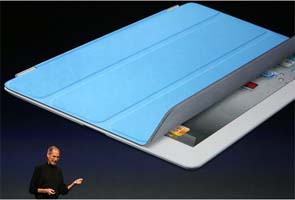
When Apple begins selling its iPad 2 on Friday evening, many of the new device's features may be upstaged by a lowly accessory, the "smart cover," a protective case designed by Apple that snaps onto the iPad through magnets and doubles as a stand.
The cover's "smarts," though, come in part from being able to turn the iPad 2 on when you open it and off when you close it. The click and finger swipe -- three to four seconds, in an unscientific test -- that stood between you and the digital world in the original iPad? Gone.
The cover turns on the iPad 2 faster than you can wake up your PC or Mac and faster than you can turn on your car or television. It is a bit like the refrigerator door. You open it, and the light goes on, revealing all there is to eat.
The smart cover underscores Apple's knack for design, not to mention the legendary marketing chops of its chief executive, Steven P. Jobs. But more than that, it taps into our apparently insatiable hunger for instant gratification and desire to be one with our favorite gadgets.
"We are in an environment where there is no downtime anymore," said Gary Small, a professor at the Semel Institute for Neuroscience and Human Behavior at the University of California, Los Angeles. "We have become impatient."
Three seconds may not be much, but it suggests to us that we may be able to send one more message or read one more tweet, he said. "Where does it end?"
The marriage of speed and technology did not start yesterday and it will not end tomorrow. When AT&T unveiled the first commercial push button phone in 1963, part of its pitch was simple: calling someone would be faster than it was on rotary phones. For years, makers of computers and Web browsers have competed on the speed of their products.
More recently, computer makers have been hard at work trying to cut the boot-up time of PCs -- minutes of idle time that have become increasingly infuriating. Most hand-held devices turn on much faster. And with its smart cover, the new iPad 2 goes one step further.
"This is the story of our lives," said James Gleick, the author of "Faster," "The Information" and other books on the cultural ramifications of technology. "These little technologies that save us a fraction of a second or a gesture, they're a form of crack."
Paul Saffo, a veteran technology forecaster in Silicon Valley, likened it to another vital need. "Connectivity has become like oxygen," he said. "If you don't have it, you notice its absence at about two seconds."
Apple has said little about the smart cover since Mr. Jobs showcased it before a rapt audience in San Francisco last week. He said the cover was not an afterthought, but was designed simultaneously with the iPad 2. To highlight its importance, Mr. Jobs gave the smart cover a starring role in its own movie -- a playful 32-second clip that, he said, reminded him of a Pixar short.
Tech bloggers are reacting with effusive praise for the cover, with comments ranging from "magical" to "mind blowing." John Gruber, an influential blogger, said the smart cover may be the main reason some owners of the original iPad want to upgrade to the new version.
How well the cover works in real life remains to be seen. Will it slip off when the iPad 2 is pulled out of a bag? Will it work as well for left-handed users and right-handed users? Will it slide easily into a larger case?
Regardless of the answers, the smart cover appears to have carved its spot in tech history, if only for the praise it has earned for its stylish marriage of form and function. "It is well on its way to becoming a design icon," Mr. Saffo said.
Maybe you can judge a tablet by its cover.





 Click to Expand & Play
Click to Expand & Play


